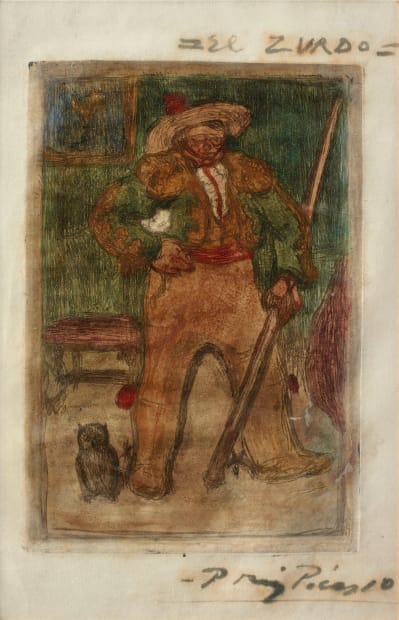We are delighted to be taking part in Portrait Mode, a nationwide celebration marking the reopening of the National Portrait Gallery in London, highlighting the wonderful range of portraits on show in collections, galleries and other spaces in the UK and internationally. To mark the occasion, we would like to highlight Le repas frugal, the iconic portrait etched by Pablo Picasso. It is the second print Picasso ever made, in September 1904 when the artist was merely 23 years old and had had no formal training in printmaking, and yet it has become an iconic work and one of Picasso’s ten most sought-after prints. Le repas frugal is the only print linked to the artist’s Blue Period, recognisable by the pervasive melancholy and poverty that the image evokes.
Fernande Olivier, one of Picasso’s first loves and muses, described Le repas frugal by saying: "Picasso was working at the time on an etching, which has become famous since: it is of a man and a woman sitting at a table in a wine-shop. There is the most intense feeling of poverty and alcoholism and a startling realism in the figures of this wretched, starving couple." (Fernande Olivier, ‘Picasso and his friends’, London 1964, p. 28).
-
-
The emaciated state of the couple can been seen in their elongated hands and chiselled features. The female figure depicts the enigmatic Madeleine, Picasso’s lover at the time. Picasso's biographer, John Richardson, has commented: "Madeleine she was called; all we know is that she was a model … she was pretty in a delicate, bird-like way (her nose and forehead formed a straight line). Madeleine’s thick hair, loosely drawn back into a chignon, and her boyishly lean body recurs in a number of works done over the next six to nine months." (John Richardson, 'A Life of Picasso', vol. I, London, 1991, p. 307). In the summer of 1904 Madeleine still played an important role in Picasso’s life in Paris although unknowingly she would soon be replaced by Olivier. Madeleine is also the figure of the superb Femme a la chemise of 1905 at Tate Modern and most possibly of the Femme au casque de cheveux of 1904 at Art Institute of Chicago, in 2017 Marilyn McCully pointed out that the figure might possibly be Antoinette Fornerod, another model who sat for Picasso at this time. The man seated next to her is a figure from the artist’s past in Barcelona which he had finally left only a few months earlier. The figure first appears in several sketches and a gouache from 1903 and then in the large painting Le repas de l’aveugle at the Metropolitan Museum of Art made in the same year. Richardson has remarked: "This [Le repas frugal] quintessential and final Blue Period iconic work links his Spanish past with his French future." (John Richardson, ‘A life of Picasso’, vol. I, London, 1991, p. 300).
-
Both the blind man from Barcelona and Madeleine from Paris would continue to haunt Picasso’s imagination. Their chiselled features and gaunt bodies re-appear in different guises until 1904-05, when the artist would start depicting acrobats, street performers and circus scenes. While Madeleine’s place would be supplanted by Olivier, the blind man (and his alter ego the minotaur) would haunt Picasso’s imagination and be embodied in his personal mythology, as Sir Roland Penrose explains: "The allegory of the blinded man has pursued Picasso throughout his life like a shadow as though reproaching him for his unique gift of vision." (Roland Penrose, ‘Picasso: His Life and Work’, London, 1981, p. 89). Blindness is also described as painters cursed illness in the Symbolist poetry of the 19th century.
With his final move from Barcelona to Paris in 1904, Picasso slowly began to shake off the gloom of the suicide of his dear friend, Carlos Casagemas in February 1901, and that of the human misery encountered in the Barrio Gótico of Barcelona. The style and mood of his work gradually changed. Melancholy, rather than intense grief, became the prevailing sentiment. This transition towards a less sombre atmosphere and ethereal elegance is manifested in Le repas frugal. The stylistic shift towards more refined, elegant figures is particularly pronounced in the print: the bodies are emaciated and their limbs elongated to the extreme – an effect that is perhaps intensified by the linear quality of the etching technique. These elements recall the Mannerist features of El Greco’s work.
The deeply bitten etched lines equally highlight the physical contact between them. This tender and poignant scene depicts human intimacy as well as melancholic introspection. There is an overall unity of balance, proportion and rhythm to the composition, through the grouping of the figures and objects, the balance of light and dark tones, and the rhythmic quality of the lines. Although the figures are united in a tender embrace, their stance is also one of emotional separation. Ambiguously, the woman’s direct gaze to the viewer and knowing smile contrasts with that of her partner, whose head is turned away from her, physically and emotionally blind as if he was searching for light. The slim, attenuated bodies and telling gestures embody universal loneliness and quiet isolation that transcends time and place. Emotional distress is further emphasised by the still-life in front of the couple. On the table are laid out some stale bread and a bottle of wine, a frugal meal from which the title of the print derives. According to Brigitte Baer, who wrote the catalogue raisonné of Picasso’s graphic works, from a visual perspective this still-life presages Cubism whereas the bread and wine on a white tablecloth are a hidden symbol of Catholic Spain.
-
-










